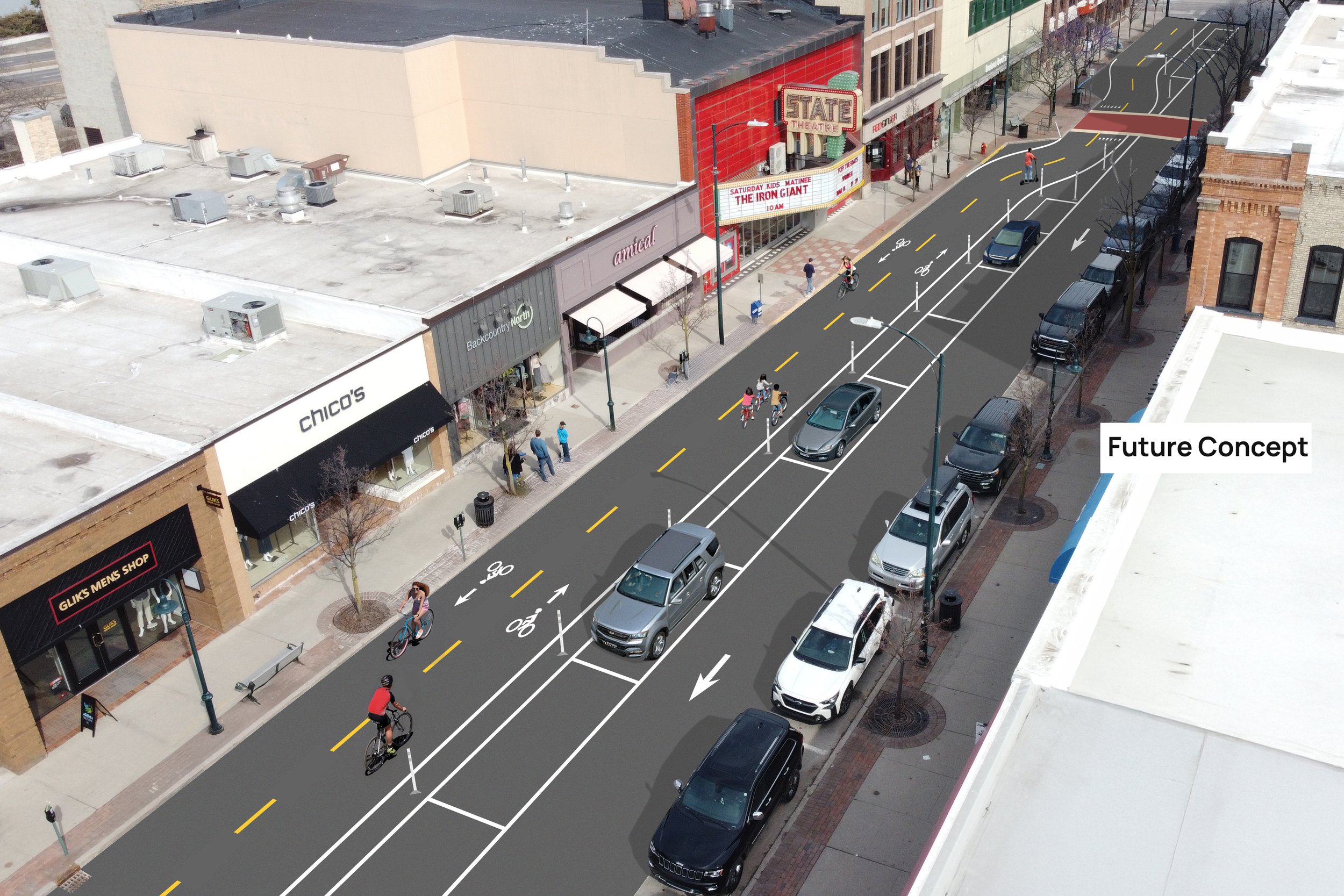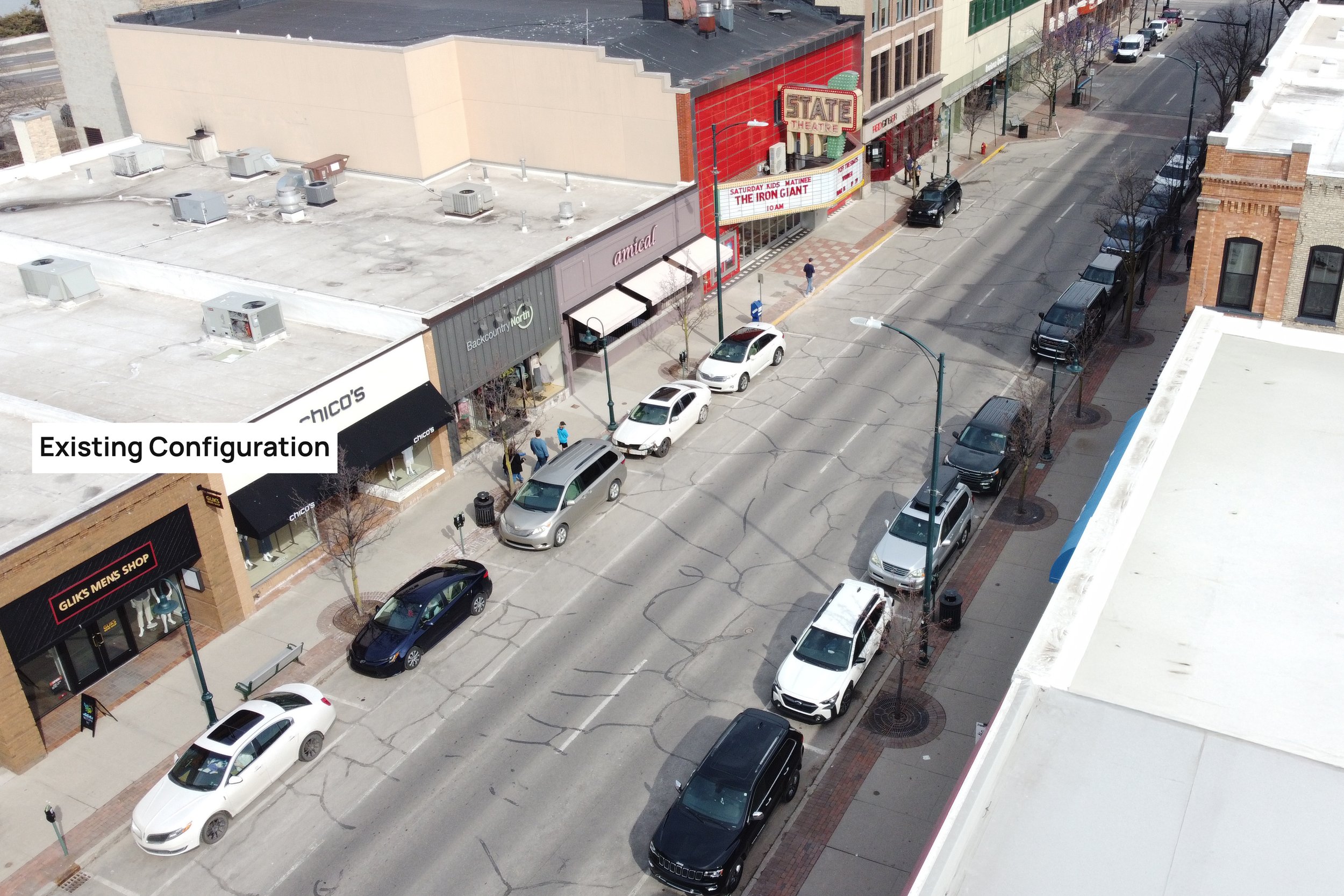A quick-build pilot project concept to optimize Front Street as it exists today to meet the current transportation demand in downtown Traverse City and adapt to changes over time
The Problem
Despite being the most significant commercial corridor in downtown Traverse City, Front Street fails to provide a safe and practical way for people to bike.
However, many residents and tourists experience Traverse City by bike. In fact, it is consistently rated one of the most bike-friendly cities in Michigan.
Still, many people restrict their riding to dedicated paths and low-stress neighborhood streets where conflict with vehicles is low. Currently, for many people, biking on Front Street feels unsafe and inconvenient.
The one-way section of Front Street between Boardman Ave and Pine St only has a single, unprotected, westbound-only bike lane sandwiched between a vehicle travel lane and parking.
This is only useful for a very small group of road users: Cyclists who feel comfortable riding alongside traffic and need to travel west.
At the same time, this section of Front Street is currently configured as a two-lane, one-way street capable of handling significantly higher average daily traffic than it currently carries.
The Opportunity
All of these factors point to a perfect opportunity to test out rethinking how we use the space on Front Street to:
Improve access to businesses
Increase safety for all road users
Connect to existing biking trail network
The Concept
The one-way section of Front Street could be temporarily reconfigured using quick-build materials to test a two-way protected cycle track while preserving on-street parking on both sides. This would repurpose one vehicle lane to better align with current transportation needs.
Quick, affordable, and adaptable
The Bike Front concept is a quick-build project that uses only paint, flexible posts, and signs to test the concept on the existing road surface without having to wait for a full reconstruction.
This significantly shortens the construction timeline and lowers the project cost. It also allows the project to easily adapt to any changes or concerns that may arise with the design over time. Insights from this pilot can help guide future permanent design choices.
The Bigger Picture
A well-connected, safe bike network is essential for encouraging ridership. If even a small portion of a route feels unsafe or uncomfortable, it can discourage many people from biking altogether.
To truly make cycling a viable and attractive option, every part of the network must feel safe, predictable, and accessible for all users.
However, the current setup does not provide comfortable east-west access across downtown or connections to the TART Bayfront trail.
The Bike Front concept would modify the existing one-way section of Front St (the four blocks between Pine St and Boardman Ave) to create a vital connection to the east-west bike network through downtown Traverse City.
This would also improve four north-south connections to create safer ways to connect to the existing TART Bayfront trail and bridge the gap between the bay and downtown.
But what about…
-
Right now, this is just a concept — not a finalized project. Our goal is to start a conversation, hear feedback, and help people visualize what’s possible on Front Street.
There’s no set timeline, and nothing is being built yet. But if the idea gains community and city support, this kind of quick-build project could be implemented in just a few days using paint, signs, and posts — no major construction needed.
-
We’d evaluate the project based on three key areas:
Are people using it?
We’ll collect usage data through counters to measure how many people bike, roll, and scoot through, especially compared to before. A visible increase in non-car trips to and through downtown would be a strong sign of success.
Does it support businesses?
Businesses are the heart of Front Street. We’ll actively seek feedback from owners and employees about how the pilot affects customer experience, foot traffic, and deliveries. Are more people stopping by? Is the street easier to navigate? If tweaks are needed, we’ll make them.
Do people like it?
We’ll have a public feedback form for residents, visitors, and anyone who experiences the project. Do people feel safer? Is it more enjoyable to spend time downtown? What could make it better?
This is a pilot, not a permanent change—so the entire purpose is to test, listen, and learn. If it works well, we’ll have the data to back it up. And if it doesn’t work, we’ll have learned that, too—with minimal cost and effort.
-
This concept is unlikely to significantly affect parking. The proposed design simply shifts the existing parking lane toward the center of the road to make room for the new bike lane. Any minor changes would be confirmed in a final engineered design, but the impact is expected to be minimal.
It will, however, give people a new way to safely access downtown without having to drive or find a parking spot to begin with.
-
Any existing on-street bike parking can be shifted over just like the vehicle parking.
The pilot project would also include looking for opportunities to add additional bike parking and figuring out which spots would work best.
-
The current traffic volumes on Front Street suggest that converting Front St to a one-lane configuration would likely have little to no impact on traffic flow for most trips.
Additionally, State St now provides a westbound lane that can help accommodate increased traffic for times that downtown experiences higher peak traffic, reducing the strain on Front St.
The addition of protected bike lanes would introduce a new, safe transportation option for people to use. Some individuals who would typically drive on Front St may opt to bike instead of driving, potentially reducing vehicle delays.
-
Front Street is a highly pedestrian-oriented street where people walk, shop, and dine—not a high-speed thoroughfare. Keeping a passing lane encourages speeding and makes the street less safe for people walking and biking. The goal isn’t to just move cars through faster—it’s to create a safe, welcoming space for everyone.
Existing bus stops and loading zones would remain to provide designated drop-off and pickup spots outside of the vehicle travel lane.
Additionally, the configuration of the existing midblock crosswalks and intersections provides frequent spaces for a vehicle to pull over in case of emergency to avoid blocking traffic.
If speed is the priority, Grandview Parkway offers a faster route through downtown.
-
The Bike Front concept plan uses the existing physical road surface to allow for testing the functionality and usage of a two-way protected cycle track without having to do any actual construction. This allows for a low cost, quick-build way to conduct the pilot project.
Widening the sidewalk would require construction. However, we can use the data and insights from this pilot project to inform a redesign plan that works better for everyone when the opportunity arises in the future to physically reconstruct the actual pavement surfaces, curbs, and sidewalks.
-
Since this is a quick-build concept, the materials like flex posts can be removed during the winter if needed. That flexibility makes it easy to test the design in the warmer months and evaluate how it’s working.
Traverse City winters can be intense, but similar designs have worked well in places like Cambridge, MA, which also manages snow and cold in downtown settings. If this project moves forward, working with the city to figure out winter operations would be a key part of how we adapt the design and could test different strategies over time.
-
This same design has been implemented in other cities across the US that have allowed the use of the two-way cycle track for emergency vehicle use if necessary. Some cities have actually found it to be beneficial for emergency vehicles as it provides an unobstructed lane immediately adjacent to the buildings on the street.
-
The Bike Front concept improves safety for pedestrians by:
Reducing the number of vehicle lanes they have to cross at intersections and midblock crosswalks.
Reducing vehicle speeding. Streets with fewer vehicle lanes have been shown to reduce vehicle speeds, lowering the likelihood of serious pedestrian crashes.
Reducing bike/pedestrian conflict. While bikes, scooters, and skates are already prohibited from riding on sidewalks on Front St, a providing dedicated space to ride would decrease the likelihood of riding on the sidewalk.
-
Modifying Front St to become a two-way street for vehicles does not address the accessibility and safety issues Front St currently faces for those interested in biking.
There is simply not enough space to provide protected cycling facilities, on-street parking, and two-way vehicle traffic. Since people are already used to this section of Front St being a westbound one-way street, it would not require a change in driver behavior to adapt to the Bike Front concept.
-
Businesses on the south side of Front St would not be affected.
On the north side, since the Bike Front concept uses adaptable, quick-build materials, the cycle track could be shifted away from the sidewalk in desired locations to make space for on-street dining spaces.
-
Designated loading zones could be marked for areas where they may be necessary. Additionally, businesses on both sides of Front St are accessible from the alleys behind the buildings.
-
Since this is a pilot project concept, it would be easy to gather feedback and data and modify the design to accommodate any necessary changes.
This is not a permanent reconfiguration of Front St—it’s a pilot project concept that would test the usage and functionality of a two-way cycle track given the space constraints of the existing infrastructure.
Additionally, you can share your feedback on the form on the page.
-
Then it can easily be modified or removed and reverted back to the original configuration. With the quick build materials, it allows the project to function as a pilot project without significant upfront investment. This allows us to test the functionality, usage, and public perception.
Worst case scenario is that it doesn’t function as well as we hoped, it isn’t used as much as we hoped, and it was reverted back without much cost or effort. Regardless, people got to experience what it would be like.
On the other hand, it could become a great asset to downtown Traverse City. It could…
Give businesses a new way for customers to get through the door
Provide a safe way for everyone of all ages and abilities to bike downtown
Create a vital east-west connection in a growing bike network
Increase pedestrian safety with shorter crossings and prevent bikes from riding on the sidewalks
Reduce dependency on driving and parking downtown




